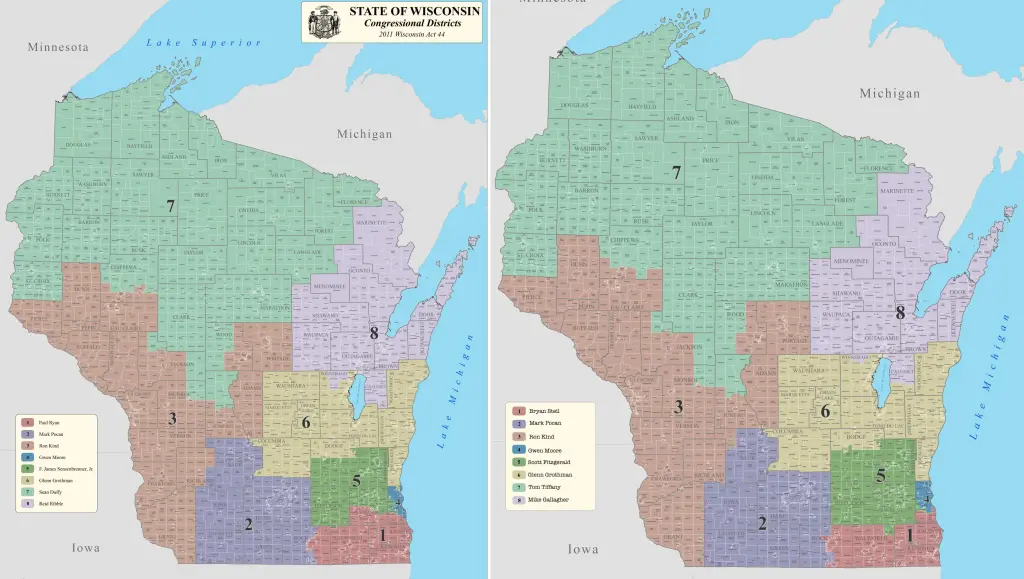Editor’s note: The following story has been shared for publication by The Badger Project, which, according to its website, is a nonpartisan, citizen-supported journalism nonprofit in Wisconsin. A link to the publication is here: https://thebadgerproject.org.
By Peter Cameron/The Badger Project
With a new left-leaning majority on the state Supreme Court, Wisconsin Democrats are salivating at the thought of ending a Republican gerrymander that has all but closed them out of power for the last 12 years.
Two lawsuits from allies of the Democratic Party have challenged the political districts of the Wisconsin State Legislature. Republicans appear so worried about the outcome that they first floated the idea of impeaching new liberal-leaning Justice Janet Protasiewicz, a maneuver many experts view as legally dubious.
Now the GOP appears to have retreated to a hastily drawn bill they say would enact a nonpartisan redistricting commission to draw the political lines. Gov. Tony Evers and fellow Democrats have rejected the bill.
Yet even with the wind at their backs, Wisconsin’s political left is declining to challenge the map of the state’s eight congressional districts. where Republicans hold a 6-2 advantage. Both lawsuits focus exclusively on the legality of the districts for the state Legislature.
“Democrats and supporting groups are focusing on what they see as the most clearly gerrymandered body,” said Joe Heim, a University of Wisconsin-LaCrosse political science professor emeritus, “which is the state Legislature.”
In a state where Democrats have dominated statewide elections in recent years, Republicans hold near two-thirds supermajorities in both houses of the Wisconsin State Legislature, a clear sign of how effective their gerrymander is, experts say. Fairer maps would give Democrats a much greater chance of retaking the Legislature, as they last did in 2008.
The congressional districts are a different story.
“Democrats don’t have much to gain within the state by redrawing the congressional districts,” Barry Burden, a political science professor at UW-Madison and director of the school’s Elections Research Center, wrote in an email. “Doing that would, at most, tilt one or two more of the eight districts in the Democratic direction.”
Given that large percentages of Democrats live in the two relatively small geographic areas of Milwaukee and Dane counties, two congressional seats out of eight “may be the best they can do,” Heim said.
Historically, Democrats have dominated in Madison and Milwaukee, while losing in rural areas. As the state’s politics have become more heated, that divide has become more pronounced. And the explosion of growth in Madison and Dane County has meant even more votes for Democrats there, making it difficult for the GOP to win at the state level.
The most striking example of the gulf may have occurred in Protasiewicz’s campaign this spring. En route to an 11-percentage point victory, she won 82% of the vote in Dane County, an astounding number even for such a deep blue place.
Dems had success rolling back congressional gerrymandering
The congressional districts were the one area where Democrats moved the needle to the left in the most recent round of redistricting.
The Wisconsin Supreme Court accepted congressional maps drawn by Democrats, and those maps made the 1st Congressional District in southeastern Wisconsin more competitive, albeit still right-leaning.
Democratic-drawn maps snipped the left-leaning city of Beloit out of the deep blue 2nd Congressional District, which mostly consists of Madison and Dane County, and moved it into the 1st to the southeast. Democrats also moved half of the college town of Whitewater and some left-leaning parts of the Milwaukee suburbs into the 1st.
Republican gerrymandering helps Democrats in one congressional district
Republican gerrymandering has actually helped Democrats in the 3rd Congressional District in western Wisconsin.
When Republicans conducted their first redistricting in 2011, they pulled the liberal college town of Stevens Point, in the middle of the state, out of the northern 7th District, which Democrat Dave Obey had held for decades, and slid it into the western 3rd District, which Democrat Ron Kind had held for years.
The GOP no doubt wanted to make the 7th District friendlier to Republicans while throwing more left-leaning votes into the 3rd, at the time a solidly Democratic district. But a shift in rural politics has made Republicans regret that move. The rural 7th District is now solidly red, and the 3rd has become more of a swing district. In their congressional maps rejected by the state Supreme Court, Republicans put Stevens Point back into the 7th, to try and make the 3rd more favorable to them.
In 2022, Democrats narrowly lost the 3rd, after the national party mostly ignored the race, thinking it a lost cause. More resources are likely to come when they challenge incumbent Republican Congressman Derrick Van Orden in 2024.
Experts generally agree that, at the moment, the very best Wisconsin Democrats can hope for in the eight congressional districts in next year’s elections is a 4-4 split, while Republicans can win up to six of the districts, as they did in 2022.
State vs. federal court
When allies of the Democrats filed their redistricting challenges with the Wisconsin Supreme Court, “it’s likely that the lawsuits focused only on state legislative races because those elections are most obviously the purview of the state Supreme Court,” Burden noted.
Adding congressional districts to the lawsuits, Burden said, might raise questions about whether those maps should be litigated in federal rather than state court.
“It is still possible that a separate case could be created that targets gerrymandering of congressional districts,” he added.
